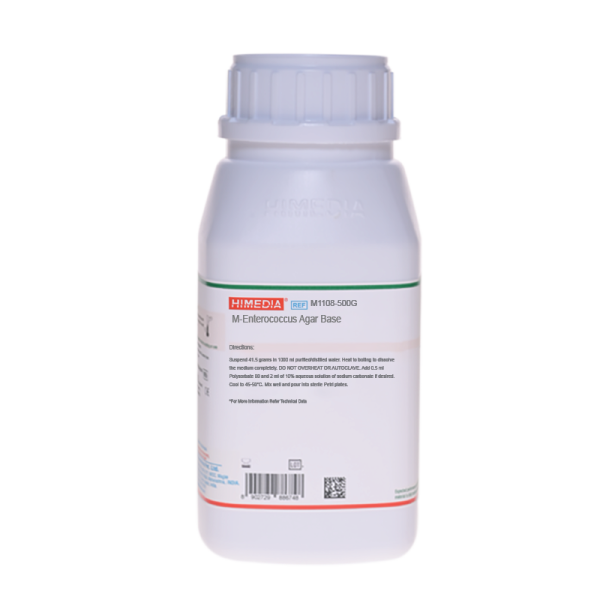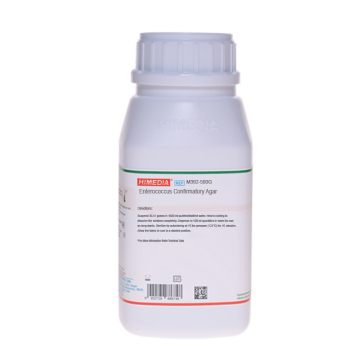 Your enquiry has been submitted
Your enquiry has been submitted
M-Enterococcus Agar Base
Faecal Streptococci#CC293D
Intended Use
Recommended for isolation and enumeration of Enterococci in water, sewage, food and other materials by membrane filtration technique as well as direct plating of specimens.
Composition
| Ingredients | Gms / Litre |
|---|---|
| Tryptone | 15.000 |
| Soya peptone | 5.000 |
| Yeast extract | 5.000 |
| Dextrose (Glucose) | 2.000 |
| Dipotassium hydrogen phosphate | 4.000 |
| Sodium azide | 0.400 |
| 2,3,5-Triphenyl tetrazolium chloride | 0.100 |
| Agar | 10.000 |
| Final pH (at 25°C) | 7.2±0.2 |
**Formula adjusted, standardized to suit performance parameters
Directions
Suspend 41.5 grams in 1000 ml purified / distilled water. Heat to boiling to dissolve the medium completely. DO NOT OVERHEAT OR AUTOCLAVE. Cool to 45-50°C. Add 0.5 ml polysorbate 80 and 2 ml of 10% aqueous solution of sodium carbonate, if desired. Dispense into Petri plates.
Principle And Interpretation
This medium was devised by Slanetz, Bent and Bartley (7) for the enumeration of Enterococci by the membrane filter technique.Slanetz and Bartley (8) modified it by the addition of Triphenyl Tetrazolium Chloride (TTC) and found that larger colonies and higher counts were obtained by placing membrane filters directly on the agar surface than on pads saturated with liquid medium. This medium is highly selective. Burkwell and Hartman used polysorbate 80 (0.5 ml/l) and sodium carbonate (2 ml of a 10% aqueous solution per litre) to increase sensitivity for direct plating of foods and increasing colony size (2). As per standard methods, M-Enterococcus Agar is used for the detection of faecal Streptococcus and Enterococcus groups using the membrane filtration technique (3).
Tryptone and soya peptone, yeast extract, dextrose act as source of carbon, nitrogen and other essential growth nutrients. Sodium azide inhibits gram-negative organisms. TTC serves as a rapid indicator of bacterial growth. TTC is reduced to insoluble formazan inside the bacterial cells, which gives red colouration to colonies.
For filtration, choose a sample size so that 20-60 colonies will result. Transfer the filter aseptically to agar medium, avoiding air bubbles beneath the membrane. The medium can also be directly inoculated by streaking the specimen and incubating the plates at 35-37°C for 24-48 hours. Incubate the plates at 35°C for 48 hours. After incubation, count all light and dark red colonies as Enterococci.
Type of specimen
Food samples; Water samples
Specimen Collection and Handling
- For food samples, follow appropriate techniques for sample collection and processing as per guidelines (6).
- For water samples, follow appropriate techniques for sample collection, processing as per guidelines and local standards.(1)
After use, contaminated materials must be sterilized by autoclaving before discarding.
Warning and Precautions
Read the label before opening the container. Wear protective gloves/protective clothing/eye protection/ face protection. Follow good microbiological lab practices while handling specimens and culture. Standard precautions as per established guidelines should be followed while handling specimens. Safety guidelines may be referred in individual safety data sheets
Limitations
- Due to varying nutritional requirements, some strains may be encountered that grow poorly.
- If the inoculum is too heavy, the sheen may be suppressed.
Performance and Evaluation
Performance of the medium is expected when used as per the direction on the label within the expiry period when stored at recommended temperature.
Quality Control
Appearance: Cream to yellow homogeneous free flowing powder
Gelling: Firm, comparable with 1.0% Agar gel.
Colour and Clarity of prepared medium: Light pink coloured clear to slightly opalescent gel forms in Petri plates.
Reaction: Reaction of 4.15% w/v aqueous solution at 25°C. pH: 7.2±0.2
pH: 7.00-7.40
Cultural Response: Cultural characteristics observed after an incubation at 35-37°C for 24-48 hours.
| Organism | Inoculum (CFU) | Growth | Colour of colony (on membrane) |
|---|---|---|---|
| Escherichia coli ATCC 25922 (00013*) | >=104 | inhibited | |
| Enterococcus faecalis ATCC 29212 (00087*) | 50-100 | good-luxuriant | pink - dark red (maroon) |
Key: (*) Corresponding WDCM numbers.
Storage and Shelf Life
Store between 10-30°C in a tightly closed container and the prepared medium at 20-30C. Use before expiry date on the label. On opening, product should be properly stored dry, after tightly capping the bottle in order to prevent lump formation due to the hygroscopic nature of the product. Improper storage of the product may lead to lump formation. Store in dry ventilated area protected from extremes of temperature and sources of ignition Seal the container tightly after use. Product performance is best if used within stated expiry period.
Disposal
User must ensure safe disposal by autoclaving and/or incineration of used or unusable preparations of this product. Follow established laboratory procedures in disposing of infectious materials and material that comes into contact with sample must be decontaminated and disposed of in accordance with current laboratory techniques (4,5).
Reference
- Baird R.B., Eaton A.D., and Rice E.W., (Eds.), 2015, Standard Methods for the Examination of Water and Wastewater, 23rd ed., APHA, Washington, D.C.
- Burkwell and Hartman, 1964, Appl. Microbiol., 12:18.
- Eaton A. D., Clesceri L. S. and Greenberg A. W., (Eds.), 1998, Standard Methods for the Examination of Water and Wastewater, 20th Ed., APHA, Washington, D.C.
- Isenberg, H.D. Clinical Microbiology Procedures Handbook 2nd Edition.
- Jorgensen, J.H., Pfaller, M.A., Carroll, K.C., Funke, G., Landry, M.L., Richter, S.S and Warnock., D.W. (2015) Manual of Clinical Microbiology, 11th Edition. Vol. 1.
- Salfinger Y., and Tortorello M.L., 2015, Compendium of Methods for the Microbiological Examination of Foods, 5th Ed., American Public Health Association, Washington, D.C.
- Slanetz, Bent and Bartley, 1955, Publ. Health. Rep., 70:67.
- Slanetz and Bartley, 1957, J. Bact., 74:591.
| Product Name | M-Enterococcus Agar Base |
|---|---|
| SKU | M1108 |
| Product Type | Regular |
| Physical Form | Powder |
| Origin | Animal |
| Packaging type | HDPE |
| References | 1. Slanetz, Bent and Bartley, 1955, Publ. Health. Rep., 70:67. |
| Customized Product Available | No |








